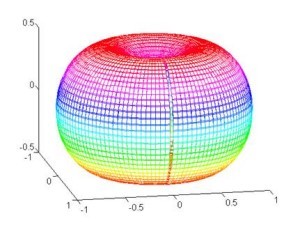
Click to rate this post!
[Total: 1 Average: 4]
The radiation pattern of an antenna is the three-dimensional representation of the gain of the antenna. It is usually preferable to consider horizontal or vertical section or section diagrams more conveniently. High gain antennas usually also have lateral lobes or secondary lobes: they represent less gain peaks than the gain of the main lobe or main beam. These side lobes limit the quality of the antenna by causing any interference on other radiocommunication systems or loss of directivity in systems where the power of the useful signal transmitted or received in a certain direction, such as radar systems, IFF radar and the radio links of the radio bridges. The figure below shows a two-dimensional radiation pattern (which could represent a vertical section or a horizontal section of the emission spectrum). Red is represented by the main lobe, in the opposite side lobe, while the lateral lobes are gray.
% diagramma di irradiazione tridimensionale di un elemento di corrente clear all
whitebg
theta=0:0.05:2*pi;
[THETA,FHI]=meshgrid(theta,theta');
k=2*pi;
UNO=exp(0.*THETA);
E=sin(THETA);
[x,y,z]=sph2cart(FHI,(pi/2)*UNO-THETA,E);
mesh(x,y,z)
view([1,5,2])
Subscribe
Login
0 Comments
Oldest





